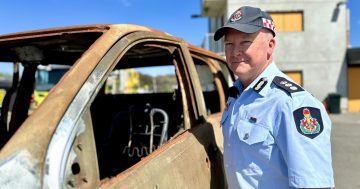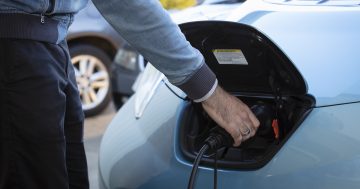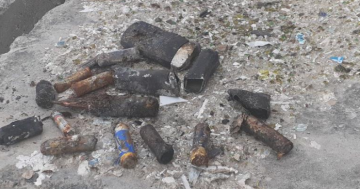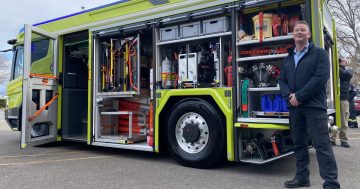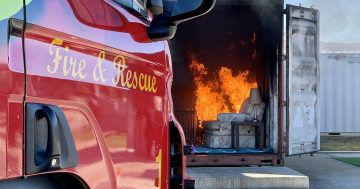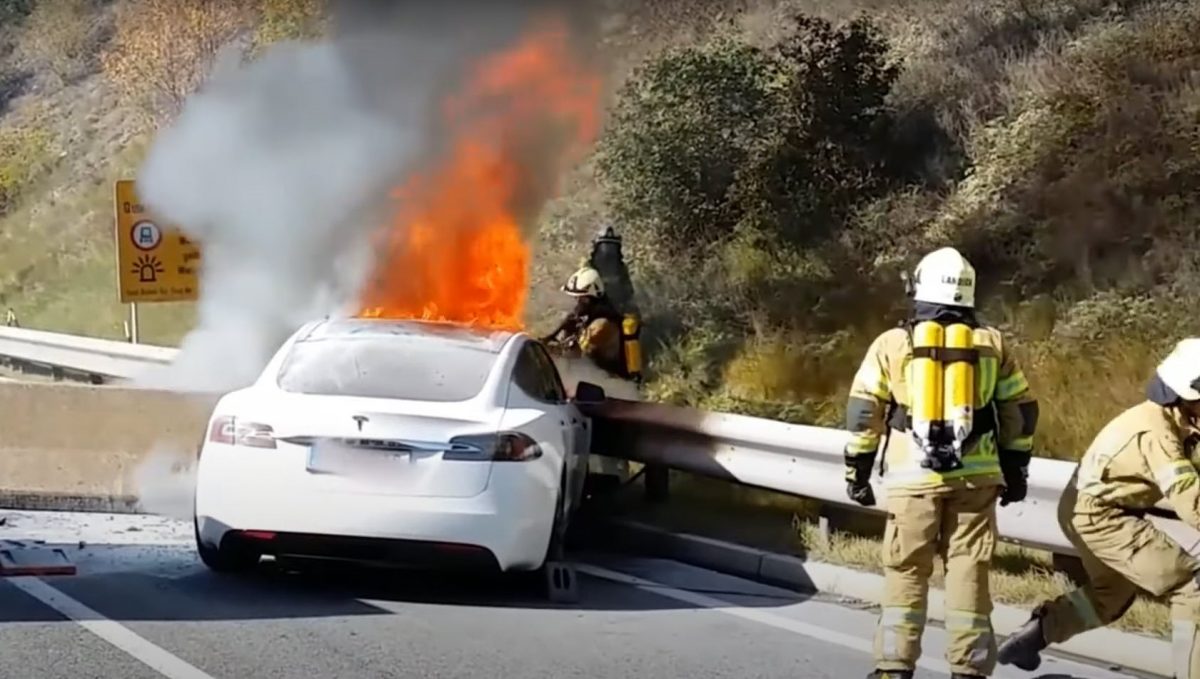
Firefighters putting out a Tesla fire overseas. Photo: Screenshot.
The ACT firefighters union has raised “sobering” concerns over what happens when an electric vehicle (EV) catches alight as the ACT Government looks at ways of speeding up the uptake of zero-emission transport.
The government heard from a variety of stakeholders last week as part of the Inquiry into EV Adoption in the ACT, as it looks to ban the sale of new fossil-fuel-powered cars by 2035.
There were 73 submissions made by members of the public, building owners and owners corporations, businesses and unions, and motoring organisations.
In its recently published submission, the ACT Branch of the United Firefighters Union of Australia (UFU ACT Branch) created a hypothetical scenario with many questions that have yet to be answered by policy or precedent.
Here’s the scenario: An EV collides with a safety barrier on Parkes Way at the foot of Black Mountain and adjacent to Lake Burley Griffin. The battery is damaged, leading to a jet of flame from the battery.
Given that it’s a lithium-ion battery fire, the firefighters must figure out how they can get hold of up to 60,000 litres of water they might need to put out (and there are no hydrants on Parkes Way). How can it be transported fast enough? And how can it be deployed without causing significant erosion and environmental damage to the land around it? What about the fumes? How long would traffic be disrupted?
An unlikely scenario? Maybe not.
Something like it happened on 30 May 2021 at the Fyshwick recharging station for the Beam e-scooters.
The fire was extinguished, but emergency services stayed on site for another two days in case the fire reignited. One battery did, on 1 June, and then again six weeks later on 14 July.
Worksafe ACT launched an investigation and closed the warehouse. It’s still under investigation.
Still, it’s not exactly common.
Reported experience from overseas says EV fires account for 1 in 40 of all car fires. In his 2019 article entitled ‘A Better Fire and Rescue Service for the ACT: Context, pressures and organisational challenges’, Professor David Hayward noted, “these vehicles are no more likely to be involved in fires than conventional vehicles”.
“But when they are involved with fires, the fire management risks are high.”
As of 6 March, 3552 battery electric vehicles are registered in the ACT, a growth of more than 3000 in three years. And that’s before we count e-bikes, e-scooters, hoverboards, electric motorbikes and electric trucks. Not even the light rail vehicles – with one to two tonnes of battery coming on board soon – is exempt.
There will be an accident one day, and our firefighters want to be ready for that day.
The UFU ACT Branch stands for the “industrial, professional, health, safety and wellbeing interests of career firefighters and communications officers employed by ACT Fire and Rescue”. It describes itself as “generally supportive of greater uptake of EVs”.
“The UFU has a significant record in advocating for measures aimed at addressing climate change, and the challenges posed to firefighters by extreme weather events,” the submission reads.
But their submission included a YouTube video compilation showing several instances of EVs catching fire overseas.
The fire danger of lithium-ion batteries stems from something called ‘thermal runaway’.
In the same way a mobile phone heats up when being charged, when a battery is damaged or pierced, the energy escapes in the form of extreme heat. A fire or explosion can result, with temperatures reaching 1600 Celsius.
In the meantime, all car fires are highly toxic, but lithium-ion battery fires emit what specialists often refer to as ‘The Terrible Twins’: carbon monoxide and hydrogen cyanide. These poison the body’s organs when inhaled and, in the case of related gas, hydrogen fluoride, cause swelling and scarring to the lungs. Future cancer certainly isn’t out of the question.
The trouble is, traditional firefighting foam doesn’t work to put it out and water can make it even worse.
“Cooling the battery to suppress the thermal runaway can be effective, however, there are reports of water causing an explosion,” the union said.
‘Drowning’ the fire seems to be the only current option. Typically, this requires a deluge of 1125 litres of water per minute and between 2000 and 60,000 litres of water in total.
For perspective, the average Canberra home uses 200,000 litres per year, while the average conventional car fire uses less than 1400 litres.
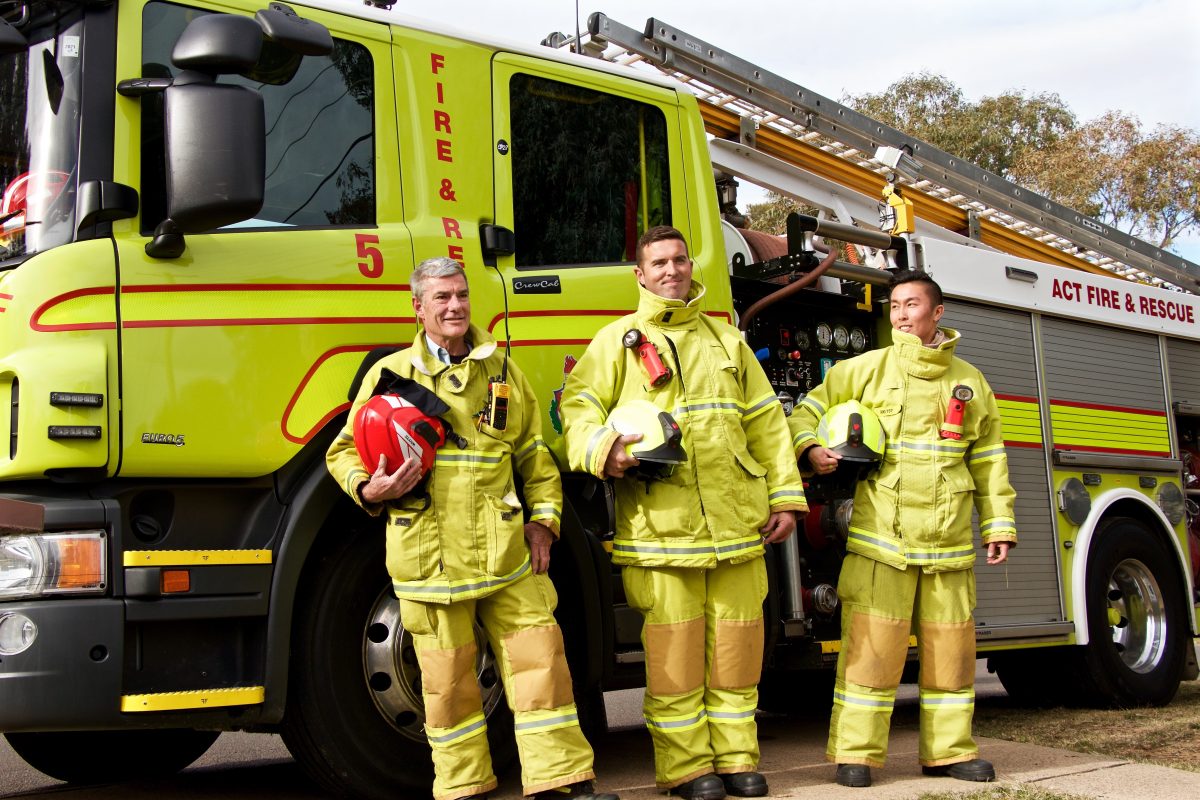
ACT Fire and Rescue trucks carry about 1400 litres of water – insufficient to extinguish an EV fire. Photo: Michael Weaver.
This is where it gets tricky because the pumper trucks in ACT Fire & Rescue’s fleet can only hold about 1400 litres of water. This means around 43 truckloads of water could be required to put out an EV fire where there’s no access to a hydrant.
It’s not over then, either.
Once the battery is cool, emergency services must wait 45 minutes and retest for heat. And the vehicle has to be stored at least 15 metres from other objects to avoid a domino-effect fire. And all this without the firies being “effectively electrocuted while trying to manage the fire”.
“Noting the requirements for thermal runaway suppression, it is not difficult to imagine a scenario which typifies some of the challenges in the context of Canberra’s environment,” the union said.
The union has seven recommendations for the ACT Government, starting with an education program for emergency services workers in the police, fire and ambulance fields and general road users.
“That ACT Fire & Rescue approval be required in the setting of standards and thresholds pertaining to the fire safety and suppression features of ‘Electric Vehicle Ready Buildings’,” reads another.
And “that the ACT Government support the further research of the work health and safety implications of firefighter chemical exposure arising from thermal runaway events”.
They also call for the government to adopt an Australian standard when it comes to the storage of batteries and charging facilities.
“The matters raised herein are by no means comprehensive; however, they are somewhat sobering,” the submission concluded.
“Swift action by all levels of government is required to ensure that fire services are not overwhelmed by the proliferation of this developing technology.”
Submissions to the inquiry closed on 26 August 2022. The Committee will discuss the submissions with a final reporting date to be announced.












